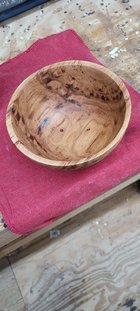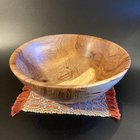-
It's time to cast your vote in the December 2025 Turning Challenge. (click here for details) -
Congratulations to Pat White for "Sicilian Mosaic" being selected as Turning of the Week for December 29, 2025 (click here for details) -
Welcome new registering member. Your username must be your real First and Last name (for example: John Doe). "Screen names" and "handles" are not allowed and your registration will be deleted if you don't use your real name. Also, do not use all caps nor all lower case.
You are using an out of date browser. It may not display this or other websites correctly.
You should upgrade or use an alternative browser.
You should upgrade or use an alternative browser.
Pecan
- Thread starter Rusty Nesmith
- Start date
- Joined
- Jul 18, 2018
- Messages
- 1,353
- Likes
- 2,932
- Location
- Baltimore, MD
- Website
- loujacobswoodturning.com
Very pretty Rusty! Nice work!!
Hickory and pecan are in the same family. Looks more like hickory to me.
- Joined
- Jul 18, 2018
- Messages
- 1,353
- Likes
- 2,932
- Location
- Baltimore, MD
- Website
- loujacobswoodturning.com
- Joined
- Jul 18, 2018
- Messages
- 1,353
- Likes
- 2,932
- Location
- Baltimore, MD
- Website
- loujacobswoodturning.com
I’m not arguing the nomenclature. Just struck by how similar they are. In fact I think they are often used, or at least named interchangeably.
Edit: I found all the blanks I cut from this tree to be harder on my tool edges than almost anything else I’ve turned. I’m assuming that the wood was laden with minerals that took the edge off.
Edit: I found all the blanks I cut from this tree to be harder on my tool edges than almost anything else I’ve turned. I’m assuming that the wood was laden with minerals that took the edge off.
Last edited:
Pecan and hickory ARE in the same genus, but different species. Botanically speaking, everything in the genus Carya is a “hickory”. I’ve found a pretty wide variation in the wood of these species. I have turned a good amount of shagbark hickory that is fairly light cream colored throughout, with a lot of spotting, but I also have a bunch of large chunks of mockernut hickory (I think) that have rich orange heartwood. And, I’ve turned a good amount of pecan that was dark orange/brown (the calabash I posted to the gallery, for example), instead of the characteristic creamy light brown color as in Rusty’s nice second bowl he posted.
Last edited:
All those black spots make me thing of the wood starting to degrade, so not quite rotting. I would fill them all with CA glue and dust. Nice colors and form.
robo hippy
robo hippy
- Joined
- Apr 27, 2004
- Messages
- 9,309
- Likes
- 6,080
- Location
- Lakeland, Florida
- Website
- www.hockenberywoodturning.com
Reed, I think those spots might be bird pecks. They tend to get repaired with something that looks like heartwood.All those black spots make me thing of the wood starting to degrade, so not quite rotting. I would fill them all with CA glue and dust. Nice colors and form.
robo hippy
The bird peck wood is quite solid.
Sapsuckers make a lot of them then come back to eat the trapped insects. They tend to be around a growth ring for the year or so the birds were working the tree.
- Joined
- Jul 18, 2018
- Messages
- 1,353
- Likes
- 2,932
- Location
- Baltimore, MD
- Website
- loujacobswoodturning.com
Boy, I learn something every time I log onto this site. Thanks Al! Makes perfect sense.
I have seen similar marks in white oak and am fairly positive that wood peckers had penetrated the bark in their search for insects and yes they don't degrade the wood.Reed, I think those spots might be bird pecks. They tend to get repaired with something that looks like heartwood.
The bird peck wood is quite solid.
Sapsuckers make a lot of them then come back to eat the trapped insects. They tend to be around a growth ring for the year or so the birds were working the tree.
Tom Gall
TOTW Team
I've never turned pecan. But some well known woodturner(s) refer(s) to the dry wood as Pecan-crete!!!I’m not arguing the nomenclature. Just struck by how similar they are. In fact I think they are often used, or at least named interchangeably.
Edit: I found all the blanks I cut from this tree to be harder on my tool edges than almost anything else I’ve turned. I’m assuming that the wood was laden with minerals that took the edge off.
Oh yeah! That pecan calabash I turned was from a pretty dry chunk. Was like a bucking bronco roughing it out.I've never turned pecan. But some well known woodturner(s) refer(s) to the dry wood as Pecan-crete!!!
The wood Rusty used is nice, but a lot of pecan is plain. It looks great spalted.
Well, I don't think those came from the sapsuckers. Those types of holes, from sapsuckers, are all around the outsides of the tree. These are in heart wood, and run down or along the grain. I have turned a piece or two, but not hickory/pecan, that had the sapsucker holes in it. They were only on the surface, and vanished if I took off more than about 1/4 inch. I know the pileated woodpeckers will cut large holes in tree trunks go give the bugs a good start, but again, I don't think this is what happened here.
robo hippy
robo hippy
- Joined
- Jul 18, 2018
- Messages
- 1,353
- Likes
- 2,932
- Location
- Baltimore, MD
- Website
- loujacobswoodturning.com
But remember Robo, at one point those rings were the outside of the tree.
Pecan is really beautiful wood.
The heartwood/sapwood transition can be amazing from buttery to walnut dark.
Lots of bark inclusions and colorations make every piece interesting.
I do like it a lot
But it seems to like a sharp tool and the tools that touch it don't seem to stay sharp long.
Don't bother turning off your grinder when you're turning a dried pecan rough out.
Its hard to get a nice finish surface without sandpaper.
The heartwood/sapwood transition can be amazing from buttery to walnut dark.
Lots of bark inclusions and colorations make every piece interesting.
I do like it a lot
But it seems to like a sharp tool and the tools that touch it don't seem to stay sharp long.
Don't bother turning off your grinder when you're turning a dried pecan rough out.
Its hard to get a nice finish surface without sandpaper.
Hockenberry is correct.Well, I don't think those came from the sapsuckers. Those types of holes, from sapsuckers, are all around the outsides of the tree. These are in heart wood, and run down or along the grain. I have turned a piece or two, but not hickory/pecan, that had the sapsucker holes in it. They were only on the surface, and vanished if I took off more than about 1/4 inch. I know the pileated woodpeckers will cut large holes in tree trunks go give the bugs a good start, but again, I don't think this is what happened here.
robo hippy
Hickory/Sphyrapicus varius - Bugwoodwiki
Isn't it possible that the damage one year was minimal and the tree survived then added a new annual ring etc.Well, I don't think those came from the sapsuckers. Those types of holes, from sapsuckers, are all around the outsides of the tree. These are in heart wood, and run down or along the grain. I have turned a piece or two, but not hickory/pecan, that had the sapsucker holes in it. They were only on the surface, and vanished if I took off more than about 1/4 inch. I know the pileated woodpeckers will cut large holes in tree trunks go give the bugs a good start, but again, I don't think this is what happened here.
robo hippy
I am still going to hold out for the tree having rot and/or degrading problems. The black spots run up and down the tree, and mirrored from one side to the other of the bowl. Yes, the early holes might have been made and grown over, but I think the sap suckers and wood peckers will continue to drill out the same holes over time to allow the bugs to get into the tree, and they come back for seconds. Maybe yes on tree defect, maybe yes on bird damage, maybe yes on both...
robo hippy
robo hippy



